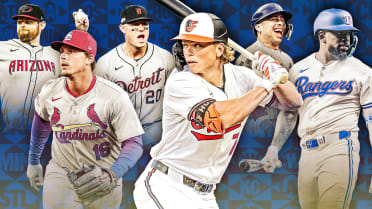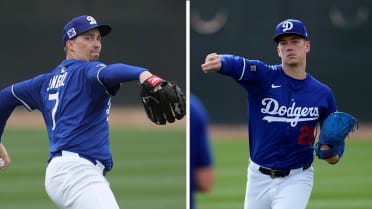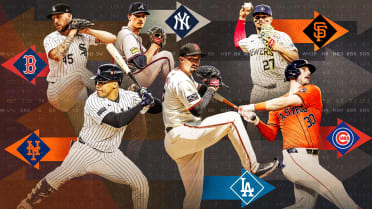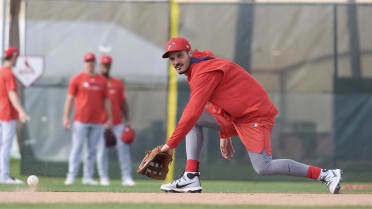The Padres then and now
This year's All-Star Game host has fought hard to secure a foothold in San Diego since 1969
Atop the grassy hill beyond center field at Petco Park stands a monument that's among the most frequented in San Diego. The nine-and-a-half-foot bronze statue depicts the late Tony Gwynn in mid-swing, the arc of his bat slicing above the tribute inscribed to "Mr. Padre."
"One of the sweetest swings I've ever seen," fellow Hall of Famer Ted Williams said of Gwynn during a visit to his native San Diego. "I just hope Padres fans appreciate what they have seen over the years."
If the bronze likeness is any proof, Padres fans certainly appreciate, if not idolize, their icon. For nearly half of the franchise's Major League history, Gwynn was the constant in a story that resembles a wild roller-coaster ride.
As Gwynn once said himself, "It takes love and resilience to be a Padres fan. Things happen here. Why? We're the Padres."
There have been incomparable highs, such as the 1984 and 1998 National League championship teams -- although both had the misfortune of running into two of baseball's all-time great teams, the '84 Tigers and '98 Yankees, respectively, in the World Series -- and the 2004 opening of Petco Park. There have also been some devastating lows, such as in 1973, when it seemed like the 4-year-old National League expansion team was bound for Washington, D.C., or the "fire sale" in the early 1990s that saw many of the Padres' best parts depart.
As with any team, many players have come and gone over the years -- even Williams. Back in 1936, shortly after the original Padres joined the Pacific Coast League, 17-year-old Ted went straight from graduation at Hoover High in the North Park neighborhood to the outfield at Lane Field. The "Padres" played 33 seasons in the PCL before San Diego was awarded a National League expansion team on May 27, 1968.
"Touch-and-go," is the way founding Padres president E.J. "Buzzie" Bavasi described the process by which San Diego was awarded a franchise over options such as Buffalo, Milwaukee and Dallas. But even on the day that celebrations broke out across San Diego, there was uncertainty. Original Padres Owner C. Arnholt Smith expressed surprise at the $10.5 million cost of getting a franchise. But Smith paid the price, and the Padres were born.
In the years since, the franchise has secured two NL pennants and five NL West titles, as well as welcomed two All-Star Games prior to this one. Additionally, the Padres have groomed two Hall of Famers in outfielders Gwynn (inducted in 2007) and Dave Winfield (2001). Nine other players, plus former Manager Dick Williams, passed through San Diego en route to Cooperstown, which is also the eternal home of beloved Padres announcer and ambassador Jerry Coleman, who was inducted in 2005 as the winner of the prestigious Ford C. Frick Award for broadcasting.
Plenty of award winners have worn Padres uniforms through the years, too. Third baseman Ken Caminiti was unanimously named the National League MVP in 1996, the year the club won its second NL West title. Four Padres pitchers -- Randy Jones (1976), Gaylord Perry ('78), Mark Davis ('89) and Jake Peavy (2007) -- have won NL Cy Young Awards in the franchise's near-50-year history. Trevor Hoffman was the first closer in MLB history to reach the 500- and 600-save plateaus, and his name is now permanently attached to the National League Reliever of the Year Award.
In 1976, Padres pitcher Butch Metzger won the NL Rookie of the Year Award, and 11 years later, a free-agent signee out of Puerto Rico named Benito Santiago received the same honor after his 34-game hitting streak set records as the longest ever by both a Major League catcher and a rookie. Bruce Bochy and Bud Black were both National League Managers of the Year in 1996 and 2010, respectively.
In addition to the aforenamed players, first baseman Nate Colbert, shortstop Garry Templeton and former Owner Ray Kroc are enshrined in the Padres Hall of Fame, which formally opened at Petco Park this summer. Williams was added to the ranks just before the All-Star Game to celebrate his role with the original Padres and his contributions to baseball in San Diego, while Caminiti will enter the team hall in August.
Although MLB's Padres were officially born on Opening Day 1969, arguably the single most important moment in franchise history came on Jan. 25, 1974: the day Kroc purchased the Padres from Smith for $12 million.
Eight months earlier, Smith had reached an agreement to sell the Padres to businessman Joseph Danzansky, who planned to move the franchise to Washington, D.C. In fact, there were reports that the team might move during the 1973 season rather than wait until the offseason. Over the winter, Topps even printed baseball cards that featured the Washington Padres. But a series of legal challenges in San Diego forced Danzansky to withdraw, and Smith began a search for a new buyer.
Enter Kroc, of McDonald's fame. The hamburger magnate and lifelong baseball fan was on his yacht off the coast of Florida when he first read of the Padres' plight. Within days, he was in negotiations to buy the beleaguered franchise. Padres history immediately changed course.
On Opening Day in 1974, with the Padres losing to the Astros, 9-2, Kroc grabbed the public address microphone at San Diego Stadium and shouted: "Fans, I suffer with you … I've never seen such stupid ball playing in my life!" Padres faithful, if not the on-field product that particular day, had finally found their champion.
Kroc ended all speculation about the team's future, investing in players, adding free agents and drafting the likes of Gwynn. Under the new owner's leadership, Jones and Winfield, who had reached the Major Leagues days apart the previous June, quickly developed into the Padres' first nationally recognized stars.
Although it took a decade for the Padres to win a title, they were on their way. Sadly, Kroc was not there to see one of the Padres' finest hours; the beloved owner passed away on Jan. 14, 1984, just months before the Padres began their first National League pennant-winning campaign.
The day the Padres secured the 1984 pennant holds special memories for the team and its fans. But so does Oct. 3. That day, the Padres lost Game 2 of the best-of-five NLCS at Wrigley Field to slip to the brink of elimination. Their flight home was delayed, so it was after 10 p.m. by the time the team buses reached the parking lot of San Diego's Jack Murphy Stadium. "We were down and extremely tired," recalls Templeton. "But as we approached the parking lot, we could see all these cars and people at the stadium.
"My first thought was that there had been some other event there that night -- oh, great."
But the crowd was there to welcome the Padres home. Most of the fans had been gathered for more than two hours, and they cheered as every player stepped off the bus. "We were mobbed and embraced," says catcher Terry Kennedy. "I'm thinking 'Don't they know we lost?'"
"I've never been part of anything like that," said Gwynn. "We're down two-zip and the fans are celebrating like we're champions. Tempy turned to me and said, 'We're not losing to the Cubs.'"
And they didn't. The Padres won Game 3 at home, 7-1. First baseman Steve Garvey hit a walk-off homer to win Game 4. And on Oct. 7, after falling behind, 3-0, in the decisive fifth game, the Padres came back to defeat the Cubs, 6-3 -- taking the lead on a two-run double by Gwynn -- to win their first National League title and a trip to the World Series.
The Padres wouldn't win another division title until 1996, and wouldn't earn their next National League pennant until 1998, a pivotal year in club history. A franchise-record 98-win season and a victory over the Atlanta Braves in the National League Championship Series inspired the city to pass the bond financing the construction of Petco Park with nearly 60 percent of the vote.
"The 1998 team was the best I played on," said Gwynn. "We were pretty solid at every position and had pitchers like Kevin Brown, Andy Ashby, Sterling Hitchcock and Hoffy, who always came through when needed."
But the roller coaster hit the skids again after the high of '98. The Padres' next National West title didn't come until their second season at Petco Park, in 2005. They made it back-to-back division titles in '06. The only thing missing from those latter triumphs was Gwynn.
"[He] was a rare ballplayer beyond the numbers," said Coleman, who chronicled Gwynn's two decades as a Padre. "He showed up to play every day with a smile for the fans."
Gwynn's "Mr. Padre" status encompasses much more than statistics, however stellar they may be. He finished his playing career with the Padres in 2001 with 3,141 hits and a .338 career batting average, the highest mark since Williams' .344.
Today, Gwynn remains the Padres' career leader in nearly every offensive category. When he retired, he ranked 18th on baseball's all-time lists in hits and doubles, and finished ninth in singles. His eight batting titles are tied for the most in National League history, and in the strike-shortened 1994 season, Gwynn finished six points shy of becoming the Major Leagues' first .400 hitter since Williams in 1941.
"Most teams have never had a Gwynn and will likely never have one," the Splendid Splinter once said of his friend. "He is a San Diego treasure."
This article appears in the MLB Official All-Star Game Program. Click here to purchase a copy, and read more features on allstargame.com.
Bill Center spent 47 years covering the Padres for The San Diego Union-Tribune and is a contributor to Padres.com and Friar Wire.



